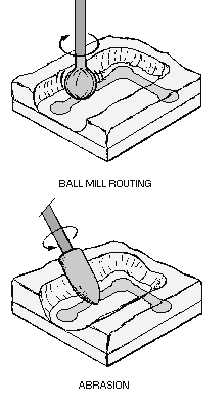3-6
Figure 3-3.—Rotary tool conformal coating removal.
CUT AND PEEL.—Silicone coatings (also referred to as RTV) can easily be removed by cutting
and peeling. As with all mechanical removal methods, care must be taken to prevent damage to either
components or boards.
CHEMICAL REMOVAL.—Chemical removal uses solvents to break down the coatings. General
application is not recommended as the solvent may cause damage to the boards by dissolving the adhesive
materials that bond the circuits to the boards. These solvents may also dissolve the POTTING
COMPOUNDS (insulating material that completely seals a component or assembly) used on other parts
or assemblies. Only thin acrylic coatings (less than 0.025 inch) are readily removable by solvents. Mild
solvents, such as ISOPROPYL ALCOHOL, XYLENE, or TRICHLOROETHANE, may be used to
remove soluble coatings on a spot basis.
Evaluations show that many tool and technique combinations have proven to be reliable and
effective in coating removal; no single method is the best in all situations. When the technician is
determining the best method of coating removal to use, the first consideration is the effect that it will have
on the equipment.
Conformal Coating Replacement
Once the required repairs have been completed the conformal coating must be replaced. To ensure
the same protective characteristics, you should use the same type of replacement coating as that removed.

